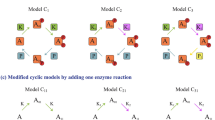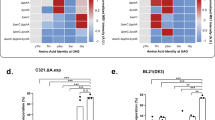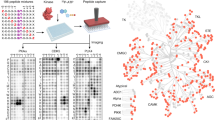Abstract
Reversible phosphorylation on serine, threonine and tyrosine is the most widely studied posttranslational modification of proteins1,2. The number of phosphorylated sites on a protein (n) shows a significant increase from prokaryotes, with n ≤ 7 sites, to eukaryotes, with examples having n ≥ 150 sites3. Multisite phosphorylation has many roles4,5 and site conservation indicates that increasing numbers of sites cannot be due merely to promiscuous phosphorylation. A substrate with n sites has an exponential number (2n) of phospho-forms and individual phospho-forms may have distinct biological effects6,7. The distribution of these phospho-forms and how this distribution is regulated have remained unknown. Here we show that, when kinase and phosphatase act in opposition on a multisite substrate, the system can exhibit distinct stable phospho-form distributions at steady state and that the maximum number of such distributions increases with n. Whereas some stable distributions are focused on a single phospho-form, others are more diffuse, giving the phospho-proteome the potential to behave as a fluid regulatory network able to encode information and flexibly respond to varying demands. Such plasticity may underlie complex information processing in eukaryotic cells8 and suggests a functional advantage in having many sites. Our results follow from the unusual geometry of the steady-state phospho-form concentrations, which we show to constitute a rational algebraic curve, irrespective of n. We thereby reduce the complexity of calculating steady states from simulating 3 × 2n differential equations to solving two algebraic equations, while treating parameters symbolically. We anticipate that these methods can be extended to systems with multiple substrates and multiple enzymes catalysing different modifications, as found in posttranslational modification ‘codes’9 such as the histone code10,11. Whereas simulations struggle with exponentially increasing molecular complexity, mathematical methods of the kind developed here can provide a new language in which to articulate the principles of cellular information processing12.
This is a preview of subscription content, access via your institution
Access options
Subscribe to this journal
Receive 51 print issues and online access
$199.00 per year
only $3.90 per issue
Buy this article
- Purchase on Springer Link
- Instant access to full article PDF
Prices may be subject to local taxes which are calculated during checkout




Similar content being viewed by others
References
Walsh, C. T. Posttranslational Modification of Proteins (Roberts and Company, 2006)
Cohen, P. The role of reversible protein phosphorylation in health and disease. Eur. J. Biochem. 268, 5001–5010 (2001)
Gnad, F. et al. PHOSIDA (phosphorylation site database): management, structural and evolutionary investigation, and prediction of phosphosites. Genome Biol. 8, R250 (2007)
Cohen, P. The regulation of protein function by multisite phosphorylation — a 25 year update. Trends Biochem. Sci. 25, 596–601 (2000)
Holmberg, C. I., Tran, S. E. F., Eriksson, J. E. & Sistonen, L. Multisite phosphorylation provides sophisticated regulation of transcription factors. Trends Biochem. Sci. 27, 619–627 (2002)
Wu, R. C. et al. Selective phosphorylations of the SRC-3/AIB1 coactivator integrate genomic responses to multiple cellular signaling pathways. Mol. Cell 15, 937–949 (2004)
Park, K.-S., Mohapatra, D. P., Misonou, H. & Trimmer, J. S. Graded regulation of the Kv2.1 potassium channel by variable phosphorylation. Science 313, 976–979 (2006)
Nurse, P. Life, logic and information. Nature 454, 424–426 (2008)
Sims, R. J. & Reinberg, D. Is there a code embedded in proteins that is based on posttranslational modification? Nature Rev. Mol. Cell Biol. 9, 815–820 (2008)
Jenuwein, T. & Allis, C. D. Translating the histone code. Science 293, 1074–1080 (2001)
Turner, B. Cellular memory and the histone code. Cell 111, 285–291 (2002)
Cohen, J. E. Mathematics is biology’s next microscope, only better; biology is mathematics' next physics, only better. PLoS Biol. 2, e439 (2004)
Hunter, T. The age of crosstalk: phosphorylation, ubiquitination and beyond. Mol. Cell 28, 730–738 (2007)
Ferrarese, A. et al. Chemical dissection of the APC repeat 3 multistep phosphorylation by the concerted action of protein kinases CK1 and GSK3. Biochemistry 46, 11902–11910 (2007)
Phanstiel, D. et al. Mass spectrometry identifies and quantifies 74 unique histone H4 isoforms in differentiating human embryonic stem cells. Proc. Natl Acad. Sci. USA 105, 4093–4098 (2008)
Pesavento, J. J., Bullock, C. R., LeDuc, R. D., Mizzen, C. A. & Kelleher, N. L. Combinatorial modification of human histone H4 quantitated by two-dimensional liquid chromatography coupled with top down mass spectrometry. J. Biol. Chem. 283, 14927–14937 (2008)
Goldbeter, A. & Koshland, D. E. An amplified sensitivity arising from covalent modification in biological systems. Proc. Natl Acad. Sci. USA 78, 6840–6844 (1981)
Lisman, J. E. A mechanism for memory storage insensitive to molecular turnover: a bistable autophosphorylating kinase. Proc. Natl Acad. Sci. USA 82, 3055–3057 (1985)
Salazar, C. & Höfer, T. Allosteric regulation of the transcription factor NFAT1 by multiple phosphorylation sites: a mathematical analysis. J. Mol. Biol. 327, 31–45 (2003)
Markevich, N. I., Hoek, J. B. & Kholodenko, B. N. Signalling switches and bistability arising from multisite phosphorylation in protein kinase cascades. J. Cell Biol. 164, 353–359 (2004)
Gunawardena, J. Multisite protein phosphorylation makes a good threshold but can be a poor switch. Proc. Natl Acad. Sci. USA 102, 14617–14622 (2005)
Kim, S. Y. & Ferrell, J. E. Substrate competition as a source of ultrasensitivity in the inactivation of Wee1. Cell 128, 1133–1145 (2007)
Ozbudak, E. M., Thattai, M., Lim, H. N., Shraiman, B. I. & van Oudenaarden, A. Multistability in the lactose utilization network of Escherichia coli. Nature 427, 737–740 (2004)
Sha, W. et al. Hysteresis drives cell-cycle transitions in Xenopus laevis egg extracts. Proc. Natl Acad. Sci. USA 100, 975–980 (2003)
Ferrell, J. E. & Machleder, E. M. The biochemical basis of an all-or-none cell fate switch in Xenopus oocytes. Science 280, 895–898 (1998)
Manrai, A. & Gunawardena, J. The geometry of multisite phosphorylation. Biophys. J. 95, 5533–5543 (2008)
Monod, J. & Jacob, F. General conclusions: teleonomic mechanisms in cellular metabolism, growth and differentiation. Cold Spring Harb. Symp. Quant. Biol. 26, 389–401 (1961)
Berger, S. L. The complex language of chromatin regulation during transcription. Nature 447, 407–411 (2007)
Huang, C.-Y. F. & Ferrell, J. E. Ultrasensitivity in the mitogen-activated protein kinase cascade. Proc. Natl Acad. Sci. USA 93, 10078–10083 (1996)
Cornish-Bowden, A. Fundamentals of Enzyme Kinetics 2nd edn 23–28 (Portland Press, 1995)
Acknowledgements
This work was supported in part by the NIH under grant R01-GM081578. We thank A. Manrai for scientific discussions, R. Ward for editorial help and HMS RITG for support with cluster computing. We acknowledge the encouragement of the late Stephen Thomson (1946–2006) and Charles Gunawardena (1929–2007).
Author information
Authors and Affiliations
Corresponding author
Supplementary information
Supplementary Information
This file contains Supplementary Data and Discussions, Supplementary References, Supplementary Table 1 and Supplementary Figures 1-2 with Legends. (PDF 431 kb)
Rights and permissions
About this article
Cite this article
Thomson, M., Gunawardena, J. Unlimited multistability in multisite phosphorylation systems. Nature 460, 274–277 (2009). https://doi.org/10.1038/nature08102
Received:
Accepted:
Published:
Issue Date:
DOI: https://doi.org/10.1038/nature08102
This article is cited by
-
Bifunctional enzyme provides absolute concentration robustness in multisite covalent modification networks
Journal of Mathematical Biology (2024)
-
A robust method for designing multistable systems by embedding bistable subsystems
npj Systems Biology and Applications (2022)
-
The Kinetic Space of Multistationarity in Dual Phosphorylation
Journal of Dynamics and Differential Equations (2022)
-
Algebra, Geometry and Topology of ERK Kinetics
Bulletin of Mathematical Biology (2022)
-
Multiple random phosphorylations in clock proteins provide long delays and switches
Scientific Reports (2020)
Comments
By submitting a comment you agree to abide by our Terms and Community Guidelines. If you find something abusive or that does not comply with our terms or guidelines please flag it as inappropriate.



